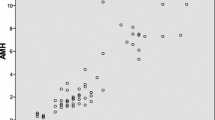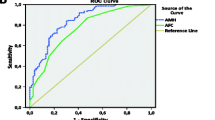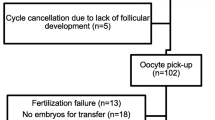Abstract
Aim
To compare the efficacy of three methods: the levels of anti-müllerian hormone (AMH), the levels of follicle stimulating hormone (FSH) and the antral follicle count (AFC), for the prediction of the number of retrieved mature oocytes and the number of generated embryos by intracytoplasmic sperm injection (ICSI) in women stimulated with a GnRH-antagonist protocol.
Materials and methods
105 women were enrolled in the study. At the day 2 of a preceding cycle, AFC was performed and FSH and AMH were measured in serum by immunoenzymatic assays. All women were stimulated with a GnRH-antagonist protocol and ovulation was induced with human chorionic gonadotropin. ICSI was performed in all retrieved mature oocytes. Embryo transfers were performed at days 2–3. According to the oocytes retrieved, patients were categorized as poor (<4), normal (4–12) or high responders (>12).
Results
AFC and the levels of baseline FSH and AMH were significantly different among poor, normal and high responders. The number of oocytes as well as the number of embryos was negatively correlated with baseline FSH and positively correlated with baseline AMH and AFC, whereas AFC showed the strongest correlation. Stepwise regression analysis indicated AFC and baseline AMH as the most significant parameters for the prediction of the number of oocytes; for the prediction of the number of embryos, the most significant parameter was AFC.
Conclusions
AFC, baseline AMH and baseline FSH are good predictors for the outcome of ovarian stimulation in GnRH-antagonist cycles. However, AFC appears to have the best predictive value.
Similar content being viewed by others
References
Kolibianakis EM, Griesinger G, Tarlatzis BC (2012) GnRH-antagonists in ovarian stimulation for IVF. In: Gardner DK, Weissman A, howles CM, Shoham Z (eds) Textbook for Assisted Reproductive Techniques, 4th edn, vol 2, clinical perspectives. Informa healthcare, pp 124–131
Johnson J, Canning J, Kaneko T, Pu JK, Tilly JL (2004) Germline stem cells and follicular renewal in the postnatal mammalian ovary. Nature 428(6979):145–150
Fauser BC, Diedrich K, Devroey P, Evian Annual Reproduction Workshop Group 2007 (2008) Predictors of ovarian response: progress towards individualized treatment in ovulation induction and ovarian stimulation. Hum Reprod Update 14(1):1–14
Tsepelidis S, Devreker F, Demeestere I, Flahaut A, Gervy Ch, Englert Y (2007) Stable serum levels of anti-Müllerian hormone during the menstrual cycle: a prospective study in normo-ovulatory women. Hum Reprod 22:1837–1840
Baczkowski T, Kurzawa R, Glabowski W (2004) Methods of embryo scoring in in vitro fertilization. Reprod Biol 4(1):5–22
Penarrubia J, Fábeques F, Manau D, Creus M, Casals G, Casamitjana R et al (2005) Basal and stimulation day 5 anti-mullerian hormone serum concentrations as predictors of ovarian response and pregnancy in assisted reproductive technology cycles stimulated with gonadotropin-releasing hormone agonist—gonadotropin treatment. Hum Reprod 20(4):915–922
Van Rooij IA, Broekmans FJ, te Velde ER, Fauser BC, Bancsi LF, Jong FH et al (2002) Serum anti-mullerian hormone levels: a novel measure of ovarian reserve. Hum Reprod 17:3065–3071
Muttukrishna S, McGarrigle H, Wakim R, Khadum I, Ranieri DM, Serhal P (2005) Antral follicle count, anti-mullerian hormone and inhibin B: predictors of ovarian response in assisted reproductive technology? BJOG 112:1384–1390
Elgindy EA, El-Haieg DO, El-Sebaey A (2008) Anti-mullerian hormone: correlation of early follicular, ovulatory and midluteal levels with ovarian response and cycle outcome in intracytoplasmic sperm injection patients. Fertil Steril 89:1670–1676
Lekamge DN, Barry M, Kolo M, Lane M, Gilchrist RB, Tremellen KP (2007) Anti-mullerian hormone as a predictor of IVF outcome. Reprod Biomed Online 14:602–610
Broer SL, Mol BW, Hendriks D, Broekmans FJ (2009) The role of antimullerian hormone in prediction of outcome after IVF: comparison with the antral follicle count. Fertil Steril 91(3):705–714
Jayaprakasan K, Campbell B, Hopkisson J, Johnson I, Raine-Fenning N (2010) A prospective, comparative analysis of anti-Mullerian hormone, inhibin-B, and three-dimensional ultrasound determinants of ovarian reserve in the prediction of poor response to controlled ovarian stimulation. Fertil Steril 93(3):855–864
Broer SL, Dolleman M, Opmeer BC, Fauser BC, Mol BW, Broekmans FJ (2011) AMH and AFC as predictors of excessive response in controlled ovarian hyperstimulation: a meta-analysis. Hum Reprod Update 17(1):46–54
Broer SL, van Disseldorp J, Broeze KA, Dolleman M, Opmeer BC, Bossuyt P et al (2013) Added value of ovarian reserve testing on patient characteristics in the prediction of ovarian response and ongoing pregnancy: an individual patient data approach. Hum Reprod Update 19(1):26–36
Eldar-Geva T, Ben-Chetrit A, Spitz IM, Rabinowitz R, Markowitz E, Mimoni T et al (2005) Dynamic assays of inhibin B, anti-mullerian hormone and estradiol following FSH stimulation and ovarian ultrasonography as predictors of IVF outcome. Hum Reprod 20:3178–3183
Kwee J, Schats R, McDonnell J, Themmen A, de Jong F, Lambalk C (2008) Evaluation of anti-müllerian hormone as a test for the prediction of ovarian reserve. Fertil Steril 90:737–743
Fanchin R, Mendez Lozano DH, Frydman N, Gougeon A, di Clemente N, Frydman R et al (2007) Anti-müllerian hormone concentrations in the follicular fluid of the preovulatory follicle are predictive of the implantation potential of the ensuing embryo obtained by in vitro fertilization. J Clin Endocrinol Metab 92(5):1796–1802
Conflict of interest
All authors declare that they have participated to this study and approved the final version submitted to your journal. Also all authors declare that there is no conflict of interest.
Author information
Authors and Affiliations
Corresponding author
Rights and permissions
About this article
Cite this article
Tsakos, E., Tolikas, A., Daniilidis, A. et al. Predictive value of anti-müllerian hormone, follicle-stimulating hormone and antral follicle count on the outcome of ovarian stimulation in women following GnRH-antagonist protocol for IVF/ET. Arch Gynecol Obstet 290, 1249–1253 (2014). https://doi.org/10.1007/s00404-014-3332-3
Received:
Accepted:
Published:
Issue Date:
DOI: https://doi.org/10.1007/s00404-014-3332-3




